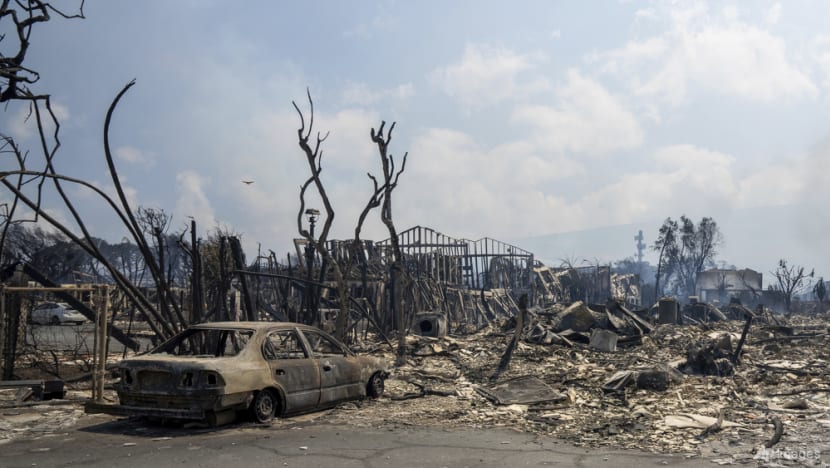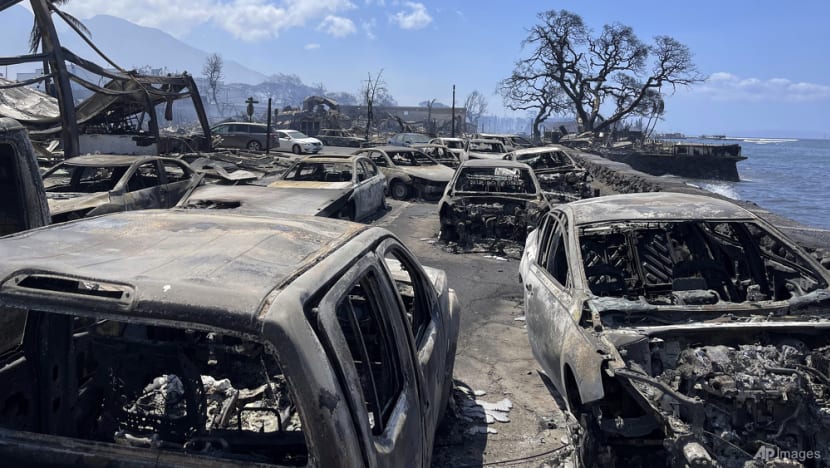High temperatures, dry vegetation and strong winds: Deadly combination for rapid spread of Hawaii’s wildfire
A deadly wildfire on the west coast of Hawaii's Maui island rapidly engulfed the seaside town of Lahaina on Tuesday (Aug 8), forcing some trapped residents to jump into the ocean to escape the flames.

A combination of high temperatures, very dry vegetation and strong winds fuelled a wildfire that devastated a Hawaiian town this past week, experts told CNA on Friday (Aug 11).
They added that wildfires can affect people far away from the site of the fire itself, such as through dangerous smoke particles that damage their physical health, along with the mental trauma that victims suffer.
The fire on the west coast of Hawaii's Maui island broke out on Tuesday and rapidly engulfed the seaside town of Lahaina.
Many residents were trapped along streets and some were forced to jump into the ocean to escape the fast-moving flames.
The blaze left the town in ruins and killed at least 53 people.
CAUSES OF THE WILDFIRE
Professor Erica Fleishman, director of the Oregon Climate Change Research Institute at Oregon State University, said the coincidence of intense heat, dry vegetation and high winds accelerated the spread of the fire.
“The wind played a very large role in making the wildfire spread quite rapidly and making it very difficult to contain. The vegetation that the wildfire is going through … is quite dry right now. Much of Maui is in drought,” she told CNA’s Asia First on Friday (Aug 11).
Dr Mojtaba Sadegh, Associate Professor at Boise State University, told CNA that the number of people exposed to wildfires and living within the boundary of hotspots have more than doubled across the US.
“We have built our houses in areas that are fire-prone across the west … and we have built them with fire-prone material. We have timber, we have got shingles that are asphalt-based. These are all burnable materials,” he said.
He added that climate change is also making it easier for disastrous fires to start, with dry, hot and windy situations – recipes for disastrous fires – happening way more frequently.
Dr Sadegh noted that the 2018 Camp Fire in California killed 85 people, while the 2021 Marshall Fire in Colorado burnt some 1,000 houses to the ground in one day.
“When you have wind, it is super difficult (and) it's just not possible to suppress those fires quickly enough. It comes back to pre-fire management,” he said.
“Basically in (Hawaii), this is a grass fire that spreads so quickly during high wind. So what could have been done was to reduce the grass load before the dry season really comes in and allow for that grass to catch fire and spread around.”
Another prevention strategy could be to harden the houses and remove vegetation around the buildings, so that when the ignition happens, it becomes easier for the firefighters to cope, he said.

Prof Fleishman noted that there are many opportunities to better protect people's health and livelihood, but it requires “political will”.
“It requires reallocation of resources and often working with the affected communities in local areas to say, ‘What resources are most important to you? What do you feel is best for you to be able to safeguard people's lives and health and things that you care about?’,” said Prof Fleishman.
“So while there's not necessarily one solution in all cases, I think there is a lot of reason for hope that even as it may be very difficult to prevent wildfires from happening … there may be some opportunities to reduce those negative effects.”
IMPACT OF WILDFIRES
Dr Sadegh said the impact of wildfires on air quality can be short-lived or long-lived, and can also affect residents thousands of kilometres away from the fire itself.
“There are several pollutants that are released to the water resources post-fire,” he added, noting that there are toxic materials released from buildings being burned too.
These materials go into the air and will be released in the months to come through rainfall, wind erosion and other weather events, he said.

Prof Fleishman said research has suggested that the long-term effects of exposure to smoke can be fairly severe for people of all ages, and for livestock and wild animals as well.
“There are some long-term effects certainly for the people who are displaced. It's quite difficult mentally in addition … also difficult for some of the places that receive the evacuees, especially a long-term evacuation,” she said.
Dr Sadeigh noted that those who had to flee the fire are vulnerable to suffering mental trauma.
“They basically resorted to jumping into the ocean to be later secured by the coast guard. That trauma is not going to go away anytime soon,” he said.
He added that for Hawaii, which depends heavily on tourism, it will take several years, even decades, to get the economy back on track. The extent of economic loss means that the community’s ability to build back up will also be limited.
Prof Fleishman said that more parts of the world are becoming dry and wildfire prone, so there have been higher frequencies of wildfires than in past decades and centuries.
Noting that last month was the hottest month on record globally, Prof Fleishman said: “The climate is changing. It is becoming warmer, and it doesn't become warmer over the long term without a lot of short-term heat waves.”















